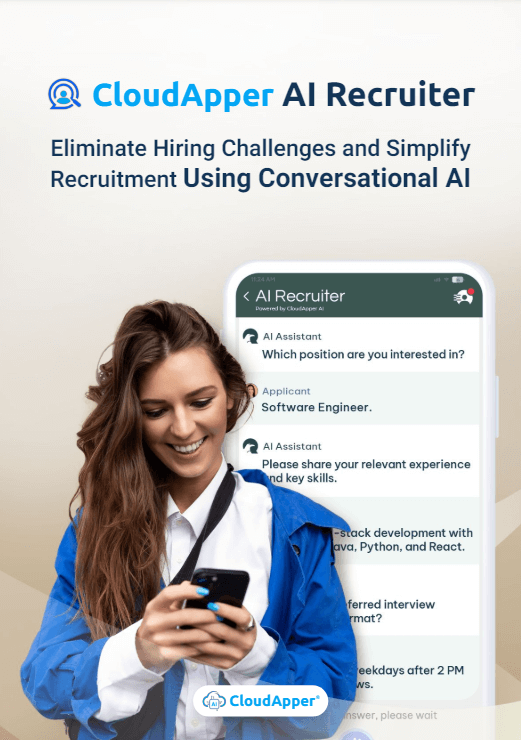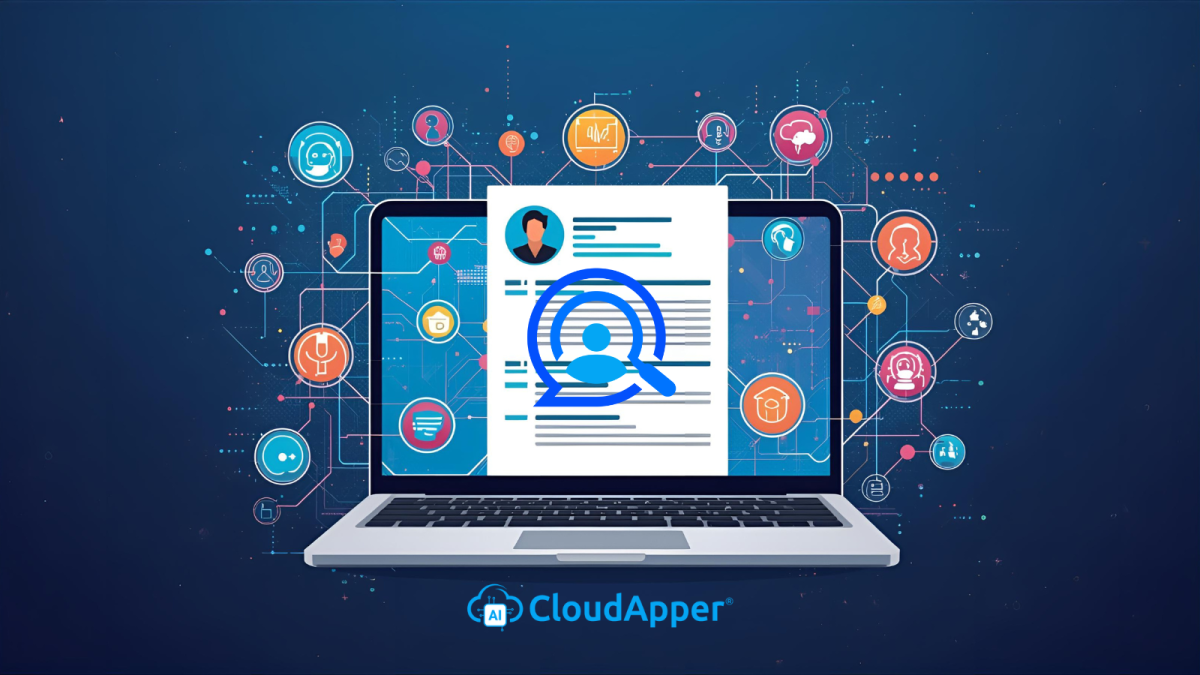Contextual resume analysis gives recruiters a clearer picture of real job skills by focusing on evidence, impact, and relevance. CloudApper AI Recruiter strengthens this approach with deeper screening, contextual evaluation, and automated engagement to highlight candidates who truly fit.
Table of Contents
In today’s high-volume hiring environment, many recruiters find themselves dealing with hundreds—sometimes thousands—of resumes for a single role. It’s tempting to scan for buzzwords, tick off keyword boxes, and move quickly. But how often do you stop to ask whether those keywords reflect real job skills in context? That’s where contextual resume analysis becomes a game-changer. By looking beyond surface matches, you’re able to dig into candidates’ real achievements, responsibilities, and the underlying skills that matter most for your role.

For more information on CloudApper AI Recruiter visit our page here.
Enter CloudApper AI Recruiter. This platform is designed to bring the power of contextual resume analysis into your recruiting workflow. Rather than simply scanning for keywords, it uses deep context-based evaluation of resumes, asks personalized scenario-based questions, and automates screening, scoring, and scheduling so that you spend time on the candidates who truly match the job—both on paper and in practice.
Why Traditional Screening Falls Short
Let’s be honest—most applicant tracking systems and manual screens rely heavily on keyword matching. They ask: Does the resume say “project management,” “Java,” or “team leadership”? If yes, check. If no, discard. But this approach misses a lot:
-
A candidate might list “Java” on their resume, but did they use it professionally or simply mention it in a training environment?
-
A resume may say “led team,” but how large a team? What was the outcome?
-
Buzzwords like “agile,” “innovation,” or “synergy” can fill pages without giving you skill evidence or context.
These pitfalls lead recruiters into two problems:
-
False positives — candidates who pass the keyword test but lack the meaningful experience to deliver.
-
Missed gems — candidates whose resumes don’t match the exact keywords you chose but actually did relevant work in a different way.
That’s why moving toward contextual resume analysis isn’t just a nice-to-have—it’s becoming essential.
What Is Contextual Resume Analysis?
Contextual resume analysis means evaluating a candidate’s resume based on how their skills, experiences, and achievements map to your role—not just by checking off keywords. This involves:
-
Assessing the depth of relevant experience.
-
Understanding the circumstances and impact of their work.
-
Interpreting resumes in relation to your job description.
-
Identifying transferable skills even when the candidate used different industry terms.
When you apply this lens, you start asking: “Is this candidate using Java in production? Have they owned end-to-end delivery or simply contributed? Did they lead a team through crisis or routine?” That shift allows you to identify real job skills — not just surface matches.
How CloudApper AI Recruiter Enables Contextual Analysis
Here’s how the platform supports and amplifies your ability to use contextual resume analysis in recruitment workflows:
-
It instantly screens, scores and ranks resumes within seconds, giving you a shortlist of top-fit candidates rather than dozens of near-fits.
-
It uses deep contextual analysis — not just keyword matching — to understand relevance, outcomes and responsibilities.
-
It verifies claims via personalized, scenario-based questions during pre-screening.
-
It automates candidate scheduling, reminders, and follow-ups 24/7, which lowers candidate drop-off.
-
It integrates easily with your existing ATS or HCM so nothing in your workflow breaks.
In essence, you’re not sacrificing speed for quality—you’re getting both.
Four Steps Recruiters Can Take Right Now
While the right tool helps, recruiters still need to apply better practices. Here’s how to incorporate contextual resume analysis into your process:
-
Define the real skills you’re hiring for.
Focus on outcomes and behaviors, not just buzzwords. -
Ask for evidence of impact.
Encourage candidates to share measurable achievements, then verify via deeper screening. -
Use technology to automate and highlight top-fits.
Let the system surface the best matches using contextual scoring. -
Evaluate and iterate your approach.
Use data from your hiring outcomes to refine what “good” looks like.
The Value for Recruiters & HR Leaders
Why is contextual resume analysis so important today? It unlocks several benefits:
-
Better quality of hire thanks to experience-based screening.
-
Faster time-to-hire due to automation and smarter filtering.
-
Lower candidate drop-off because scheduling and engagement happen instantly.
-
Less bias since decisions are based on real skills and context, not prestige factors.
-
Scalability when hiring for multiple roles or during seasonal volume spikes.
Common Pitfalls and How to Avoid Them
Some common mistakes recruiters make:
-
Overemphasis on keywords
Fix: Evaluate outcomes, not terms. -
Assuming claims are always accurate
Fix: Validate through scenario-based questions. -
Manual screening at high volume
Fix: Use contextual scoring to triage first. -
Relying solely on ATS filters
Fix: Complement your ATS with intelligent screening tools.
For HR Leaders: Why This Matters at a Strategic Level
Contextual resume analysis isn’t only for recruiters — it affects the entire business:
-
More adaptable teams built on verified skills.
-
Stronger employer brand with faster and more personalized candidate engagement.
-
Lower hiring costs due to fewer mismatches and reduced vacancy time.
-
Better internal data for future hiring decisions.
FAQs About Contextual Resume Analysis
Q: How is contextual resume analysis different from keyword screening?
A: Keyword screening checks for term presence. Contextual analysis evaluates how the skills were used, the environment, and their relevance.
Q: Will I stop reviewing resumes manually?
A: You’ll still review resumes but spend your time on the shortlisted candidates who genuinely fit.
Q: Can my ATS support contextual analysis?
A: Most ATS platforms can’t. That’s why tools like CloudApper AI Recruiter layer on top to provide deeper analysis.
Q: Does this slow down my hiring process?
A: No. With automation, contextual analysis actually speeds up screening and reduces drop-off.
Wrap-Up
If you’re a recruiter or HR leader looking to improve quality of hire, reduce time-to-fill, and ensure candidates genuinely have the skills you need, contextual resume analysis is one of the most impactful improvements you can make. And with CloudApper AI Recruiter, you can scale this approach without adding more manual work.
Want to see how it all works in action? Explore CloudApper AI Recruiter
What is CloudApper AI Platform?
CloudApper AI is an advanced platform that enables organizations to integrate AI into their existing enterprise systems effortlessly, without the need for technical expertise, costly development, or upgrading the underlying infrastructure. By transforming legacy systems into AI-capable solutions, CloudApper allows companies to harness the power of Generative AI quickly and efficiently. This approach has been successfully implemented with leading systems like UKG, Workday, Oracle, Paradox, Amazon AWS Bedrock and can be applied across various industries, helping businesses enhance productivity, automate processes, and gain deeper insights without the usual complexities. With CloudApper AI, you can start experiencing the transformative benefits of AI today. Learn More

CloudApper AI Solutions for HR



- Works with
- and more.
Similar Posts

AI-Assisted Resume Fraud: What Recruiters Must Know

The Rise of ‘Live AI Assistance’ During Interviews: What Recruiters…


















